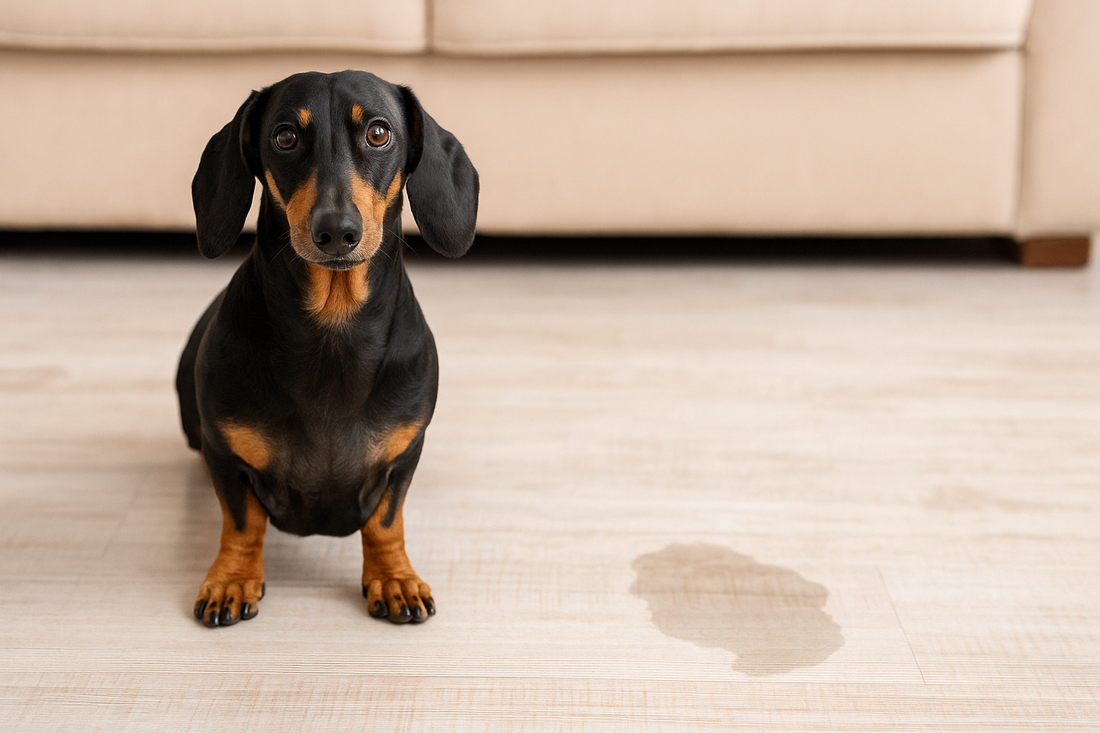
Top 5 Reasons Why Dachshunds Have Indoor Accidents And How to Fix Them
Compartir
Struggling with your Dachshund's potty habits?
You're not alone. Many doxie parents feel frustrated by unexpected indoor accidents—especially when your pup seems potty trained. But don’t worry, there's hope.
Dachshunds are fiercely loyal, endlessly curious, and adorably stubborn. Their spunky personalities make them lovable, but also a bit tricky when it comes to housebreaking. These long-bodied little adventurers often struggle with indoor accidents, especially if left alone too long or untrained. And as a doxie parent, nothing’s more disheartening than constantly cleaning up surprise puddles. Solving this issue isn’t just about cleanliness—it’s about reducing stress, building trust, and keeping your pup healthy and happy at home.
Listen: Boost Your Dachshund Myth‑Busting Episode
1. Small Bladders = Frequent Potty Breaks
Dachshunds are a small breed with proportionally small bladders, which means they physically can’t hold urine for long periods. Puppies may need to go every hour, while adult doxies typically need breaks every 3 to 4 hours—especially after eating, drinking, playing, or waking up from a nap. Skipping these opportunities can easily lead to an accident on your rug, couch, or hallway corner.
If your work schedule doesn’t allow frequent potty breaks, consider hiring a dog walker, using an indoor potty solution, or training them to use a designated area like a washable pee mat. Recognizing your Dachshund’s natural limitations is key to preventing frustration on both ends.
🎁 Pro Tip: Check out our Dachshund Urine Mat – Soft Absorbent Washable Mat – Perfect for training or backup protection when you’re not home! 🐾
2. Incomplete or Inconsistent Potty Training
Housebreaking a Dachshund takes patience, consistency, and repetition. If you’ve skipped steps or used mixed messages, your pup may not fully understand where and when to go potty. For example, letting them out to roam unsupervised too early can result in sneaky accidents. And punishing after the fact doesn’t teach them anything—it only creates fear and confusion.
Instead, stick to a structured potty training routine: take your Dachshund out at set intervals, guide them to the same potty spot, and immediately reward success with a treat and praise. Keep a journal to track potty habits if needed. Remember, potty training is not just about timing—it’s about trust.
3. Marking Territory Indoors
Marking is different from general accidents—it's instinctual and often tied to dominance or anxiety. Dachshunds may lift their leg or squat to leave tiny amounts of urine in different spots, especially when there's a new smell, item, or person in the home. This behavior is common in intact males, but females and neutered dogs can do it too.
Neutering your dog can significantly reduce marking tendencies, especially if done early. You’ll also want to eliminate all traces of urine scent using an enzymatic cleaner—standard cleaners won’t break down the smell completely, which can invite repeat marking. Keep your pup supervised indoors and block access to previously marked areas until the behavior stops.
Establishing clear boundaries and routines builds security and reduces the urge to claim space. Providing adequate exercise and mental stimulation can also reduce this need.
🎁 Pro Tip: Use our DachsyPlay™ - Dachshund Interactive Crab Toy – TThe toy is a hit with the whole family, safe for both kids and pets.
4. Separation Anxiety & Stress
Your Dachshund’s loyalty is both adorable and intense. These dogs often form deep bonds with one or two people and hate being left alone. When they’re anxious, they might whine, bark, chew furniture—or have an accident, even if they’re fully potty trained. That’s not disobedience—it’s distress.
Start by building your dog’s independence in small doses. Leave them alone for short intervals, then gradually increase the time. Don’t make a big deal out of leaving or coming home—that only adds to the emotional rollercoaster. Create a calming environment with soft bedding, chew toys, and a quiet area where they feel safe.
If separation anxiety persists, talk to your vet or a canine behaviorist. Sometimes, the stress runs deeper and may require behavioral therapy or natural calming aids.
Creating routines and giving your pup a job (like chewing a puzzle toy while you’re out) gives them purpose—and peace.
5. Health Issues or Aging
If your Dachshund suddenly starts having accidents indoors after being reliably trained, a health issue may be to blame. Common culprits include urinary tract infections (UTIs), bladder stones, kidney problems, diabetes, or even intervertebral disc disease (IVDD), which can affect their ability to get to the potty area in time.
Older Dachshunds may also experience incontinence, confusion (doggy dementia), or limited mobility—all of which can lead to accidents. If you notice frequent urination, licking the genital area, or signs of discomfort, it’s time for a vet check. Never assume behavioral issues without first ruling out medical causes.
In these cases, the best support you can offer your pup is compassion and comfort. Provide them with easy-access potty areas and soft, absorbent mats. Limit their stress, and use baby gates or washable rugs to manage their environment.
Addressing the underlying issue not only improves their health—it also rebuilds your trust and keeps your home accident-free 💧
Conclusion
While Dachshunds are prone to indoor accidents, it doesn’t mean your home has to suffer. With a little structure, love, and the right tools, you can reduce messes and build better habits. From using washable urine mats to reinforcing positive potty routines, every step helps your doxie feel secure—and your floors stay dry. 💧
Remember, the key is consistency and compassion. Your doxie wants to please you—they just need a little guidance.
Related Articles
- The Importance Of Crate Training Your Dachshund
- Obesity in Dachshunds and How to Overcome It
- Can You Leave Your Dachshund Alone? A Comprehensive Guide for Owners
👉 For more helpful tips and adorable gear, visit our blog !
